

© Shipping Wonders of the World 2012-

Beneath The Surface
A weapon of offence and defence, the submarine is one of the most interesting arms of a modern navy
THE NAVY GOES TO WORK - 3
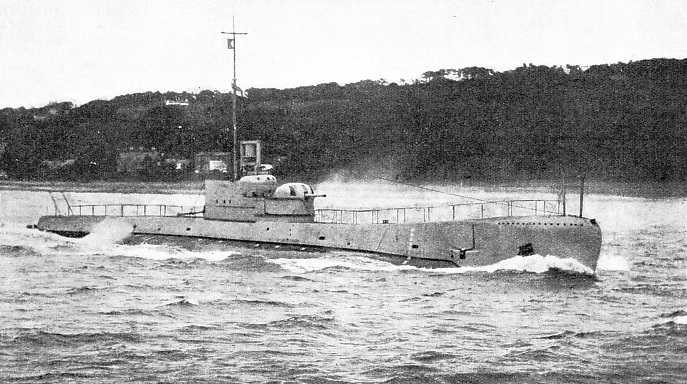
SURFACE CRUISING. One of the big Thames class submarine cruisers, each of which cost over £500,000. The displacement is 1,850/2,710 tons, and the dimensions are 325 feet by 28 feet by 13½-
OVER thirty years have passed since submarines were first used as effective weapons of naval warfare, yet to most-
The submarine is neither more nor less than a surface vessel endowed with the ability to submerge herself on occasion. A submarine normally spends most of her time on the surface of the sea, as does any other ship. She dives only to conceal herself, either for the purpose of attack or to evade pursuit. The cruising radius under water of even a large submarine is limited to a hundred miles or so. She can, however, remain motionless on the bed of the sea for periods up to three days, according to the size of the vessel and her supply of “potted” air.
In spite of attempts to abolish the submarine on humanitarian grounds, this type of warship remains in official favour as a weapon formidable both in offence and defence. At the time of writing the leading seven navies of the world possess between them 447 submarines, of which the great majority have been built since the war of 1914-
The modern form of submarine is the joint product of an Englishman, an Irishman and a Frenchman: Robert Whitehead, John Holland and Maurice Laubeuf. Whitehead, by evolving and perfecting the locomotive torpedo, provided the ideal weapon for underwater attack, and rendered inevitable the development of a vessel for carrying the torpedo into action. Holland and Laubeuf, working independently, availed themselves of the experience of earlier but little-
The submarine is a cigar-
A speed of at least four knots is necessary before these rudders can come into play. But once the submerged vessel is under their control she can be steered to, and kept at, any depth within the safety limit. This limit is fixed by the capacity of the vessel to withstand the water pressure on a submerged object. The pressure is about 45 lb. per square inch for every 100 feet of depth. On a medium-
To bring the submarine to the surface after a submerged run, the diving rudders are set at the correct angle. The vessel is then forced upwards by the thrust of her screws. When she has reached the surface, the sea water is expelled from the tanks by compressed air, thus restoring her normal buoyancy. Compressed air for “blowing” the tanks and for other purposes is stored in steel flasks at a pressure of 2,500 lb. per square inch. In most submarines there are several high-
All modern submarines are propelled on the surface by heavy-
The disadvantages of this dual system of propulsion are excessive weight in proportion to total horse-
On the surface a submarine is steered and navigated in the same way as other ships. Submerged, her only “eye” is the periscope, the optical principles of which are too well known to call for description. From the interior of the vessel this instrument can be raised to a height of about 30 feet. When, therefore, the vessel is submerged to a depth exceeding 30 feet, she is deprived of all vision and must be navigated “blind”. Methods of sound signalling below water only partly compensate for this complete lack of vision.
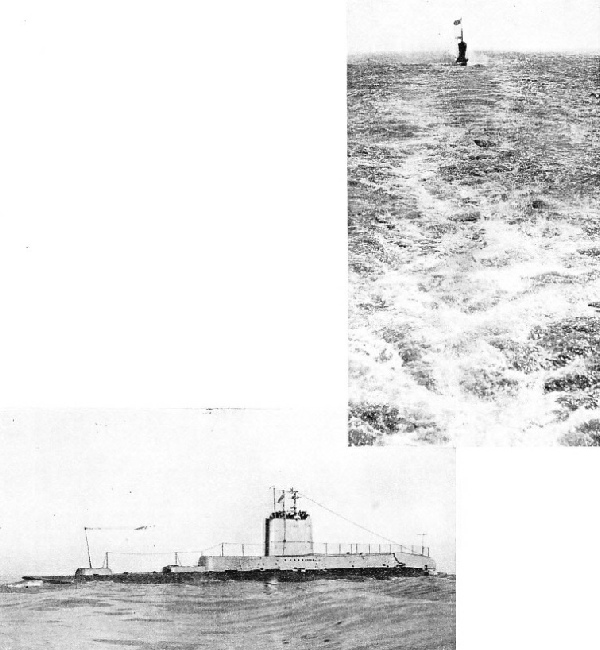
DURING MANOEUVRES (top) a submarine speeds along the surface leaving a wake of disturbed water. Below is a coastal type submarine of the Swordfish class. Her surface displacement is 640 tons and submerged 935 tons; length between perpendiculars is 187 feet. She carries six 21-
Not only does the periscope serve as an “eye” when the vessel is running submerged “at periscope depth”, but it is used also as a range-
When the sighting wires of the periscope bear on the target, the officer presses an electric button which controls an air chamber in the rear of the torpedo tube. The torpedo is then ejected from the tube by compressed air. As the torpedo passes out, a lever on the upper side is pulled back by a trip-
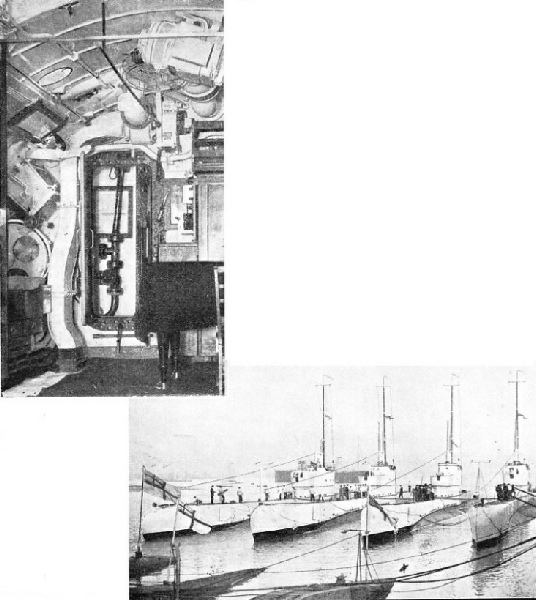
THE WARDROOM (left) of a submarine, clearly showing the watertight door. Below are four “P” class ocean-
Guns are now universally fitted to submarines, but they will always remain auxiliary weapons, chiefly for use against non-
Despite their relatively small size, submarines have a large radius of action on the surface, because of the economical running of their Diesel engines. A vessel of 1,000 tons may have a cruising endurance up to 12,000 miles, but it is doubtful whether the crew could endure the strain of so long a voyage in war conditions. Cramped living quarters, constant “tinned” air and few facilities for exercise undermine bodily and mental fitness. During the war of 1914-
It is sometimes claimed, but not by naval men, that the submarine menace has been defeated by the evolution of counter-
At the beginning of 1936 the British Navy had fifty-
The submarine cruisers Thames, Severn and Clyde, with a speed of over twenty-
The Interior of a Submarine
Below is a sectional diagram showing the general lay-
As the Diesels that drive the vessel while on the surface are now shut down, artificers are giving the machinery a brief inspection and overhaul. Other ratings are standing by the electric motors, farther aft, which drive the submarine when cruising below surface. At the fore end, members of the crew are attending to the main torpedo tubes that are the submarine’s chief weapon; she alos carries a quick-
The submarine shown here is about to submerge completely; before doing so all the hatches are closed and the wireless masts are lowered. Submerging is carried out by moving the forward hydroplanes downwards and the after ones upwards. This cause the nose of the craft to drop and the submarine glides easily below the water. While cruising at a moderate depth a foot or so of the periscope is visible above the surface. Ventilation and the necessary supply of fresh air are obtained by fans and air trunks.
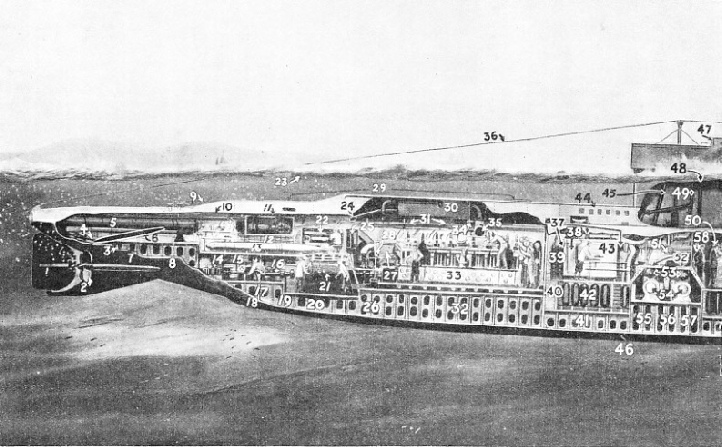
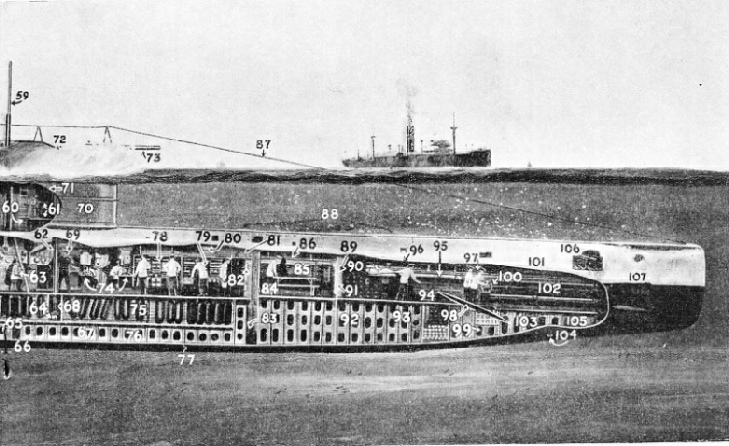
THE INTERIOR OF A SUBMARINE
1 Vertical Rudder; 2 Propellers; 3 After Trimming Tank; 4 Steering Gear; 5 Torpedo Tube; 6 After Hydroplane, or Horizontal Rudder; 7 Torpedo Tube Flooding Tank; 8 Ballast Tank; 9 Mast Lowered; 10 After Torpedo Flat; 11 Steering Gear Power Unit; 12 After Crew Space; 13 Torpedoes Stowed; 14 Thrust Blocks; 15 Auxiliary Machines; 16 Propeller Shaft; 17 Lubricating Oil Tank; 18 Wood Filling; 19 Cylinder Oil Tank; 20 Compensating Tank No 6; 21 Main Electric Motors for cruising submerged; 22 Main Motor Switch Board; 23 Surface of the Sea; 24 Exhaust Manifold; 25 Engine Room Artificers’ Locker; 26 Lubricating Oil Drain Tank; 27 Vent Tank; 28 Control Clutch for throwing Diesel Engines out of Gear before Submerging; 29 Hatches Closed; 30 Silencer; 31 Steering Rods; 32 Internal ballast Tank; 33 Diesel Motors for Surface Cruising; 34 Muffler Valve Closed; 35 Air Inlet Pipe; 36 Jumping Wire; 37 Fans; 38 Wireless Office; 39 Lockers; 40 Watertight Bulkhead; 41 No 2 Oil Fuel and Compensating Tank; 42 After Battery Tank and Compressed Air Bottles; 43 Officers’ Space; 44 Superstructure; 45 Wireless Tube; 46 After End of Detachable Iron Keel; 47 Navigating Bridge; 48 Exhaust from Forward Battery Tank; 49 After Battery Tank Exhaust; 50 Captain at Periscope; 51 Ventilating Shaft; 52 Portable Platform; 53 Torpedoes Stowed; 54 Beam Torpedo Tubes; 55 Fresh Water Tank; 56 Torpedo Tube Flooding Tank; 57 Internal Ballast Tank; 58 Third Officer Assisting Captain; 59 Periscope; 60 Hatch Closed; 61 Signal Locker; 62 Fore Periscope Lowered; 63 Steersman at Vertical Rudder Steering Wheel; 64 Periscope Eye-
You can read more on “Epics of the Submarines”, “Raising a Submarine Minelayer” and
“The Unlucky K 13” on this website.